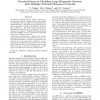Free Online Productivity Tools
i2Speak
i2Symbol
i2OCR
iTex2Img
iWeb2Print
iWeb2Shot
i2Type
iPdf2Split
iPdf2Merge
i2Bopomofo
i2Arabic
i2Style
i2Image
i2PDF
iLatex2Rtf
Sci2ools
IJPRAI
2000
2000
Practical Issues in Modeling Large Diagnostic Systems with Multiply Sectioned Bayesian Networks
As Bayesian networks become widely accepted as a normative formalism for diagnosis based on probabilistic knowledge, they are applied to increasingly larger problem domains. These large projects demand a systematic approach to handle the complexity in knowledge engineering. The needs include modularity in representation, distribution in computation, as well as coherence in inference. Multiply Sectioned Bayesian Networks (MSBNs) provide a distributed multiagent framework to address these needs. According to the framework, a large system is partitioned into subsystems and represented as a set of related Bayesian subnets. To ensure exact inference, the partition of a large system into subsystems and the representation of subsystems must follow a set of technical constraints. How to satisfy these goals for a given system may not be obvious to a practitioner. In this paper, we address three practical modeling issues.
| Added | 18 Dec 2010 |
| Updated | 18 Dec 2010 |
| Type | Journal |
| Year | 2000 |
| Where | IJPRAI |
| Authors | Yanping Xiang, Kristian G. Olesen, Finn Verner Jensen |
Comments (0)

